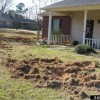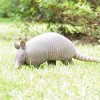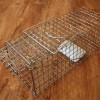 Many of us try to attract particular types of wildlife to our yards so that we can observe them. We often select plants and other materials that we know provide food, cover, and water for those animals we like to watch. However, when unwanted wildlife visit your yard and cause damage, you might need to consider the use of tactics that could deter these unwanted species. This 8-page fact sheet was written by Holly K. Ober and Arlo Kane, and published by the UF Department of Wildlife Ecology and Conservation, October 2012.
Many of us try to attract particular types of wildlife to our yards so that we can observe them. We often select plants and other materials that we know provide food, cover, and water for those animals we like to watch. However, when unwanted wildlife visit your yard and cause damage, you might need to consider the use of tactics that could deter these unwanted species. This 8-page fact sheet was written by Holly K. Ober and Arlo Kane, and published by the UF Department of Wildlife Ecology and Conservation, October 2012.
http://edis.ifas.ufl.edu/uw371
Tag: Holly K. Ober
How To Identify the Wildlife Species Responsible for Damage in Your Yard (WEC324/UW369)
 Although many homeowners enjoy wildlife in their yards, there are situations where wildlife can become a nuisance. In some circumstances, wild animals can cause extensive damage to lawns and gardens. Learning to identify which species is responsible for this damage is the first step in finding a solution to the problem. This 6-page fact sheet provides images of wildlife damage in residential settings to help you determine which species may be causing similar problems in your yard. Written by Holly K. Ober and Arlo Kane, and published by the UF Department of Wildlife Ecology and Conservation, October 2012.
Although many homeowners enjoy wildlife in their yards, there are situations where wildlife can become a nuisance. In some circumstances, wild animals can cause extensive damage to lawns and gardens. Learning to identify which species is responsible for this damage is the first step in finding a solution to the problem. This 6-page fact sheet provides images of wildlife damage in residential settings to help you determine which species may be causing similar problems in your yard. Written by Holly K. Ober and Arlo Kane, and published by the UF Department of Wildlife Ecology and Conservation, October 2012.
http://edis.ifas.ufl.edu/uw369
Overview of How to Stop Damage Caused by Nuisance Wildlife in Your Yard (WEC323/UW368)
 In Florida, we are fortunate to have a wide variety of wildlife to watch and enjoy. Indeed, many homeowners attempt to attract particular types of wildlife to their yards to watch. However, wild animals can become a nuisance in some situations. This 4-page fact sheet is the first in a five-part series describing tactics you can use to cope with wildlife that have become a nuisance. Here we suggest a sequence of steps you can implement when wildlife are causing damage in your yard. These suggestions should help reduce wildlife damage in a practical, humane, and environmentally responsible manner. Written by Holly K. Ober and Arlo Kane, and published by the UF Department of Wildlife Ecology and Conservation, October 2012.
In Florida, we are fortunate to have a wide variety of wildlife to watch and enjoy. Indeed, many homeowners attempt to attract particular types of wildlife to their yards to watch. However, wild animals can become a nuisance in some situations. This 4-page fact sheet is the first in a five-part series describing tactics you can use to cope with wildlife that have become a nuisance. Here we suggest a sequence of steps you can implement when wildlife are causing damage in your yard. These suggestions should help reduce wildlife damage in a practical, humane, and environmentally responsible manner. Written by Holly K. Ober and Arlo Kane, and published by the UF Department of Wildlife Ecology and Conservation, October 2012.
http://edis.ifas.ufl.edu/uw368
How to Modify Habitat to Discourage Nuisance Wildlife in Your Yard (WEC325/UW370)
 Although often overlooked, habitat modification is the cheapest and most effective long-term solution to nuisance wildlife problems in residential landscapes. Removing the resources wildlife are seeking when they visit your yard can be a much more cost-effective solution than restricting access to those resources with physical barriers, scaring wildlife with hazing tactics, deterring wildlife with repellents, or removing wildlife by trapping or killing nuisance animals. This 3-page fact sheet was written by Holly K. Ober and Arlo Kane, and published by the UF Department of Wildlife Ecology and Conservation, October 2012.
Although often overlooked, habitat modification is the cheapest and most effective long-term solution to nuisance wildlife problems in residential landscapes. Removing the resources wildlife are seeking when they visit your yard can be a much more cost-effective solution than restricting access to those resources with physical barriers, scaring wildlife with hazing tactics, deterring wildlife with repellents, or removing wildlife by trapping or killing nuisance animals. This 3-page fact sheet was written by Holly K. Ober and Arlo Kane, and published by the UF Department of Wildlife Ecology and Conservation, October 2012.
http://edis.ifas.ufl.edu/uw370
How to Use Traps to Catch Nuisance Wildlife in Your Yard (WEC327/UW372)
 When wildlife become a nuisance in your yard, there are three general approaches you can take: make habitat modifications, use deterrents, or trap animals. In most residential settings, making habitat modifications or using deterrents will be both simpler and more effective than trapping. But trapping is warranted in certain situations when trying to solve conflicts between people and wildlife. This 6-page fact sheet provides information on stopping wildlife damage through the use of trapping. Written by Holly K. Ober and Arlo Kane, and published by the UF Department of Wildlife Ecology and Conservation, October 2012.
When wildlife become a nuisance in your yard, there are three general approaches you can take: make habitat modifications, use deterrents, or trap animals. In most residential settings, making habitat modifications or using deterrents will be both simpler and more effective than trapping. But trapping is warranted in certain situations when trying to solve conflicts between people and wildlife. This 6-page fact sheet provides information on stopping wildlife damage through the use of trapping. Written by Holly K. Ober and Arlo Kane, and published by the UF Department of Wildlife Ecology and Conservation, October 2012.
http://edis.ifas.ufl.edu/uw372
Wildflowers Susceptible to Deer Damage in North Florida (WEC315/UW360)
 One sure way to prevent deer damage to your landscape is to choose plants that deer do not like to eat. Unfortunately deer foraging preferences vary geographically and studies conducted with captive deer aren’t always accurate. So UF/IFAS wildlife researchers investigated the foraging preference of wild white-tailed deer at two sites in Gadsden County with high deer densities for two years. Of 11 wildlfowers tested, four were very susceptible to browsing: fringeleaf tickseed, Florida tickseed, coastalplain tickseed, and orange coneflower. This 4-page fact sheet was written by Holly K. Ober, Lucas W. DeGroote, James H. Aldrich, Jefferey G. Norcini, and Gary W. Knox , and published by the UF Department of Wildlife Ecology and Conservation, December 2011.
One sure way to prevent deer damage to your landscape is to choose plants that deer do not like to eat. Unfortunately deer foraging preferences vary geographically and studies conducted with captive deer aren’t always accurate. So UF/IFAS wildlife researchers investigated the foraging preference of wild white-tailed deer at two sites in Gadsden County with high deer densities for two years. Of 11 wildlfowers tested, four were very susceptible to browsing: fringeleaf tickseed, Florida tickseed, coastalplain tickseed, and orange coneflower. This 4-page fact sheet was written by Holly K. Ober, Lucas W. DeGroote, James H. Aldrich, Jefferey G. Norcini, and Gary W. Knox , and published by the UF Department of Wildlife Ecology and Conservation, December 2011.
http://edis.ifas.ufl.edu/uw360
Baiting the Nine-banded Armadillo (WEC317/UW362)
 What is the tastiest treat to tempt an armadillo? Armadillos are one of the most significant nuisance pests in Florida and much of the Southeast. There are no repellents, toxicants, or fumigants registered for use with them. They are good at both burrowing beneath and climbing over fences. There are also no effective methods for baiting them into traps. So the authors of this 3-page fact sheet set up a test to determine which materials have the greatest potential to serve as bait. Written by Holly K. Ober, Lucas W. DeGroote, and Russell F. Mizell III, and published by the UF Department of Wildlife Ecology and Conservation, December 2011.
What is the tastiest treat to tempt an armadillo? Armadillos are one of the most significant nuisance pests in Florida and much of the Southeast. There are no repellents, toxicants, or fumigants registered for use with them. They are good at both burrowing beneath and climbing over fences. There are also no effective methods for baiting them into traps. So the authors of this 3-page fact sheet set up a test to determine which materials have the greatest potential to serve as bait. Written by Holly K. Ober, Lucas W. DeGroote, and Russell F. Mizell III, and published by the UF Department of Wildlife Ecology and Conservation, December 2011.
http://edis.ifas.ufl.edu/uw362
Management of Pine Forests for Selected Wildlife in Florida (CIR706/UW098)
 As the total number of forested acres in Florida goes down, it becomes more important that land being managed for timber production also be able to sustain healthy wildlife populations. This 9-page fact sheet shows how timber and wildlife management can be successfully combined. Written by Wayne R. Marion, George W. Tanner, Holly K. Ober, and Matthew Werner, and published by the UF Department of Wildlife Ecology and Conservation, August 2011.
As the total number of forested acres in Florida goes down, it becomes more important that land being managed for timber production also be able to sustain healthy wildlife populations. This 9-page fact sheet shows how timber and wildlife management can be successfully combined. Written by Wayne R. Marion, George W. Tanner, Holly K. Ober, and Matthew Werner, and published by the UF Department of Wildlife Ecology and Conservation, August 2011.
http://edis.ifas.ufl.edu/uw098
Farmer Perceptions of Wildlife Damage to Row Crops in North Florida (WEC311/UW356)
 How can we determine the just how much of an impact wildlife damage has on growers? This 4-page fact sheet presents the results of a survey of a sample of growers across the state. Written by Holly K. Ober, Gerald R. Edmondson, William M. Giuliano, David L. Wright, John Atkins, Andy Andreasen, Shep Eubanks, Libbie Johnson, Charles Brasher, and Greg Hicks, and published by the UF Department of Wildlife Ecology and Conservation, July 2011.
How can we determine the just how much of an impact wildlife damage has on growers? This 4-page fact sheet presents the results of a survey of a sample of growers across the state. Written by Holly K. Ober, Gerald R. Edmondson, William M. Giuliano, David L. Wright, John Atkins, Andy Andreasen, Shep Eubanks, Libbie Johnson, Charles Brasher, and Greg Hicks, and published by the UF Department of Wildlife Ecology and Conservation, July 2011.
http://edis.ifas.ufl.edu/uw356
Bats of Florida (WEC186/UW203)
Nocturnal habits, affinity for eerie places, and silent, darting flight have made bats the subjects of a great deal of folklore and superstition through the years. Given their ability to function in the dark when and where humans cannot, it is no wonder that bats have long been associated with the supernatural. Bats remain poorly understood even today. This revised 5-page fact sheet describes the species of bats that occur in Florida and provides simple tips for their identification. It was written by Holly K. Ober, Martin B. Main, and Ginger M. Allen and published by the UF Department of Wildlife Ecology and Conservation, November 2010.
http://edis.ifas.ufl.edu/uw203
WEC285/UW330 Effects of Oil Spills on Marine and Coastal Wildlife
WEC285, a 4-page fact sheet by Holly K. Ober, provides an overview of direct and indirect effects of oil spills on wildlife, factors influencing the degree of impact, susceptibility of various types of wildlife, and the history of oil spills in the Gulf of Mexico. Includes references. Published by the UF Department of Wildlife Ecology and Conservation, May 2010.
http://edis.ifas.ufl.edu/uw330
WEC274/UW319 Ten Tips for Increasing Wildlife Biodiversity in Your Pine Plantations
WEC274, a 4-page fact sheet by Holly K. Ober, Stanton Rosenthal, and William Sheftall, discusses strategies forest landowners may adopt to provide habitat that will attract a diversity of wildlife species to their land. Includes references. Published by the UF Department of Wildlife Ecology and Conservation, December 2009.
http://edis.ifas.ufl.edu/uw319
WEC273/UW318 Ten Tips for Encouraging the Use of Your Pine Plantations By Game Species
WEC273, a 4-page fact sheet by Holly K. Ober, Stanton Rosenthal, and William Sheftall, provides brief tips for making pine plantations more suitable for game species.
Includes references. Published by the UF Department of Wildlife Ecology and Conservation, December 2009.
http://edis.ifas.ufl.edu/uw318
WEC269/UW314 Forest Groundcover Restoration
WEC269, a 5-page illustrated fact sheet by Holly K. Ober and Jennifer L. Trusty, provides an overview of seven steps to follow for a successful groundcover restoration project. Includes references. Published by the UF Department of Wildlife Ecology and Conservation, November 2009.
http://edis.ifas.ufl.edu/UW314
WEC271/UW316 The Importance of Bottomland Hardwood Forests for Wildlife
WEC271, a 6-page illustrated fact sheet by Holly K. Ober, discusses the importance of seasonally flooded forests located along waterways, plants and wildlife of bottomland forests, and how to manage them for wildlife. Includes references. Published by the UF Department of Wildlife Ecology and Conservation, November 2009.
http://edis.ifas.ufl.edu/UW316
WEC-247/UW291 Conservation of Bats in Florida
WEC-247, a 4-page illustrated fact sheet by Holly K. Ober and Frank J. Mazzotti, aims to dispel fears about bats and describe their benefits, facts about bats and their habitats and how individuals can promote bat conservation. Includes references. Published by the UF Department of Wildlife Ecology and Conservation, August 2008.
http://edis.ifas.ufl.edu/UW291
WEC249/UW293 Managing Oaks to Produce Food for Wildlife
WEC-249, a 5-page illustrated fact sheet by Holly K. Ober and Patrick J. Minogue, describes the reasons homeowners should consider planting oaks, how to select the right oak species for a given site, and how to improve wildlife habitat in established stands. Includes references. Published by the UF Department of Wildlife Ecology and Conservation, August 2008.
http://edis.ifas.ufl.edu/UW293
WEC-248/UW292 The Value of Oaks to Wildlife
WEC-248, a 5-page illustrated fact sheet by Holly K. Ober, describes the value of oaks for wildlife, the food provided, differences in acorns, and other resources provided by oaks. Includes references. Published by the UF Department of Wildlife Ecology and Conservation, August 2008.
http://edis.ifas.ufl.edu/UW292
WEC-246/UW290 Effective Bat Houses for Florida
WEC-246, an 8-page illustrated fact sheet by Holly K. Ober, describes how to attact bats to your property, select a location for a bat house, how to mount it, reasons bats might stay away, and concerns. Includes references and bat house plans. Published by the UF Department of Wildlife Ecology and Conservation, August 2008.
http://edis.ifas.ufl.edu/UW290
WEC-245/UW289 Insect Pest Management Services Provided by Bats
WEC-245, a 4-page illustrated fact sheet by Holly K. Ober, uses a questions-and-answer format to provide information about this insect-eating animals role in reducing crop pests and mosquito populations in Florida, and what Floridians can do to attract bats to their property. Includes references. Published by the UF Department of Wildlife Ecology and Conservation, August 2008.
http://edis.ifas.ufl.edu/UW289